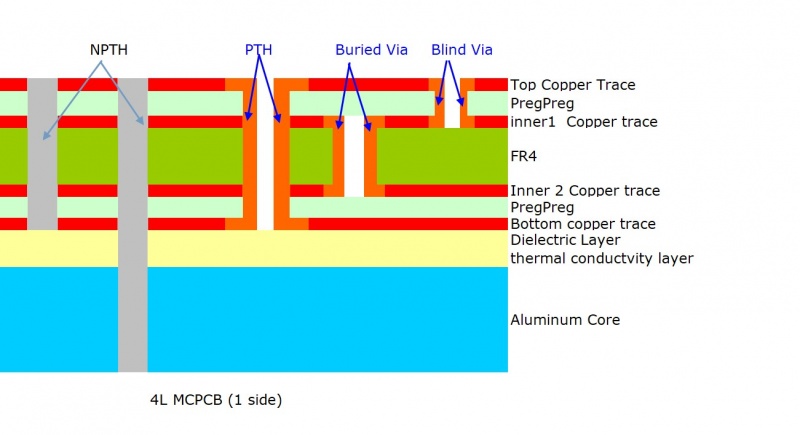What is a Multilayer Aluminum Base PCB?
- Views
- 31 Jan 2024
A multilayer aluminum PCB is a complex printed circuit board (PCB) that features multiple circuit layers on a single aluminum core. These circuit layers are separated by insulation layers, and the entire structure is designed to accommodate more circuits design in a limited space. In contrast, a single-layer aluminum PCB has only one circuit layer. Multilayer aluminum PCBs are commonly used in the manufacturing of high-density, high-performance electronic devices to meet the demands of more intricate circuit requirements.
Best Technology has extensive experience in PCB manufacturing, employing advanced technologies and equipment to custom-produce high-quality multilayer aluminum PCBs, catering to the high-performance needs of customers' electronic products. Accumulating a wealth of expertise in multilayer aluminum PCBs, we regularly manufacture boards ranging from four layers to as high as eight layers. From order placement to production, final delivery, and post-sales service, Best Technology provides comprehensive services to ensure that customers' requirements are met.
The manufacturing process of multilayer aluminum PCBs involves several key steps that are different from single-layer aluminum PCBs. Such as drilling holes, there are plated through holes in the multi-layer PCBs but not plated through holes in single-layer aluminum PCB board. What is more, it is more difficult to laminate than the similar layers of FR4 Multi layers board.
The basic structure of a multilayer aluminum PCB is illustrated as follows:

Signal integrity: The multi-layer aluminum PCB design allows better control of the signal path, reducing signal transmission delay and distortion, which helps maintain signal integrity. This is critical for high-frequency applications such as communications equipment and high-performance computer systems.
Improve design flexibility: The design of multi-layer aluminum PCB is more flexible and can accommodate more functions and components. This allows design engineers to more freely implement complex circuit functions and respond to different application requirements.
Aluminum Base PCB, Multilayer Aluminum Base PCB,
Best Technology has extensive experience in PCB manufacturing, employing advanced technologies and equipment to custom-produce high-quality multilayer aluminum PCBs, catering to the high-performance needs of customers' electronic products. Accumulating a wealth of expertise in multilayer aluminum PCBs, we regularly manufacture boards ranging from four layers to as high as eight layers. From order placement to production, final delivery, and post-sales service, Best Technology provides comprehensive services to ensure that customers' requirements are met.
The manufacturing process of multilayer aluminum PCBs involves several key steps that are different from single-layer aluminum PCBs. Such as drilling holes, there are plated through holes in the multi-layer PCBs but not plated through holes in single-layer aluminum PCB board. What is more, it is more difficult to laminate than the similar layers of FR4 Multi layers board.
The basic structure of a multilayer aluminum PCB is illustrated as follows:

Structure:
1.Metal Core Layer (Bottom Layer):
The metal core layer is only one layer on the bottom of the multilayer metal core PCB.2.Circuit Layer:
These layers are made of electrolytic copper foil. The circuit layers are more, the more complex electronic circuits you can design, meeting the demands of high-density and high-performance applications.3.Insulation Layer (Inner Layers):
The insulation layers are positioned between the metal core and circuit layers, providing electrical separation. These layers are typically composed of prepreg filled with high thermal conductivity and high insulation materials.4.Circuit Layer:
This circuit layer serves the purpose of conductivity. As a result, compared to a single-layer metal core PCB, multi-layer metal core printed circuit boards can carry higher currents.Advantage:
High performance of EMI: Multi-layer structure can provide a better EMI effect. By designing mutually canceling current loops between different layers, electromagnetic interference and radiation can be reduced, and the stability and reliability of the circuit can be improved.Signal integrity: The multi-layer aluminum PCB design allows better control of the signal path, reducing signal transmission delay and distortion, which helps maintain signal integrity. This is critical for high-frequency applications such as communications equipment and high-performance computer systems.
Improve design flexibility: The design of multi-layer aluminum PCB is more flexible and can accommodate more functions and components. This allows design engineers to more freely implement complex circuit functions and respond to different application requirements.
Application:
Multi-layer PCBs find applications in devices and systems that generate significant heat, such as LED Lighting Systems, Power Electronics Modules, Automotive Control Systems, Telecommunication Devices, and Medical Devices. The enhanced thermal performance of multi-layer PCBs helps prevent overheating of electronic components, improving the overall reliability and longevity of the electronic system.1.LED Lighting Systems:
Multi-layer metal core PCBs are employed in advanced LED lighting systems where intricate circuit designs and precise control are required.2.Power Electronics Modules:
In power modules with complex circuitry and components generating significant heat, multi-layer metal core PCBs are chosen to ensure efficient heat dissipation.3.Automotive Control Systems:
In the automotive industry, multi-layer metal core PCBs are utilized in control systems that demand a higher level of circuit integration and reliability.4.Telecommunication Devices:
Telecommunication devices often require compact designs with high heat dissipation capabilities. Multi-layer metal core PCBs are employed because their efficient thermal management is essential for optimal performance.5.Medical Devices:
Medical devices often require advanced circuit designs and reliable thermal management. Multi-layer metal core PCBs are employed in devices such as medical imaging equipment, patient monitoring systems, and diagnostic instruments, where both precision and heat dissipation are critical.Aluminum Base PCB, Multilayer Aluminum Base PCB,


